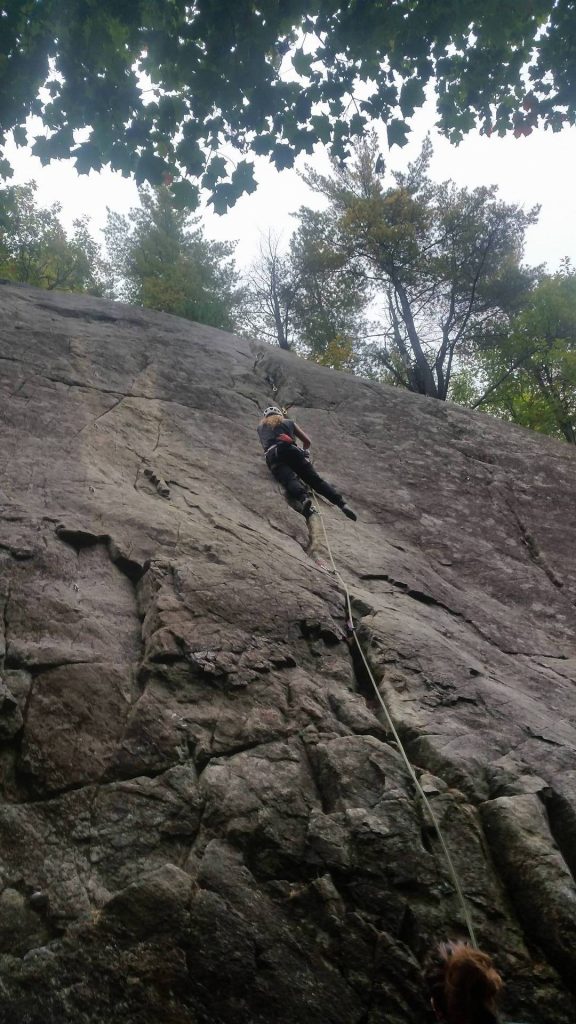Exploring the Laurentians with the Concordia Rock Climbers Association
Who would want to get up early on a Sunday, drive two hours through fog to the Laurentians and hike 15 minutes uphill all just to go rock climbing on an overcast October morning?
Concordia students would.
Matthew Packer is a business student at the John Molson Student of Business and one of the executives of the Concordia Rock Climbers Association (CRCA). Just last week, he was clinging to a cliff on Montagne d’Argent, a popular rock climbing area, leading a group of four Concordia students up the mountain in the rain. Moments earlier, the group had been staring up at him, but as the rain came down, they began rummaging through their daypacks, past peanut butter sandwiches, granola bars and harnesses, to get out their rain coats.
“Had anyone checked the weather forecast?” someone yelled.
Not a comforting thought when you’re 20 meters above the ground. Packer, along with the CRCA climbers, know that cliffs are slippery when wet. It’s usually not as enjoyable to rock climb in the rain. And yet, somehow, the group of eager young climbers are all smiles. Maybe it’s because, up until recently, this opportunity would not have been possible.
The CRCA was founded last year by two Concordia students looking to share their passion for climbing. Nicholas McCullagh, a computer science student and the CRCA’s vice president of events, got involved after he noticed the university’s outdoor club, Concordia Outdoors Club (COC), didn’t offer much for someone who was either already a passionate rock climber or looking to delve into the sport.
The four students who joined the executive team on their rainy trip to the Laurentians two weeks ago are pioneers in a sense. They are among the first people to attend a trip hosted by the CRCA, and while the group may have been small, the association’s executives are expecting a rise in membership and participation.

“Rock climbing is becoming more popular,” said McCullagh. “It’s going to be in the Olympics. There are more gyms opening up. The community is expanding.”
An increase in the CRCA’s popularity may take some strain off COC, whose trips are often at full capacity. The club hosts frequent hiking trips to mountains such as St-Sauveur and Orford. They hire busses to transport as many as 45 students to and from the hikes.
Brynn Low, one of the COC’s co-presidents, said that the strain of running such a large group is being felt at the top.
“Our participation this year has gone up over 100 per cent. All of our events have sold out in literally minutes,” Low said. “It’s been insane. It’s awesome but it’s a lot.”
The COC’s hikes are meant to be entry-level, providing the opportunity for city-dwelling students to get outside and meet new people. They are open to Concordia students interested in getting some exercise away from the city.
“We try and do hiking trips almost every weekend in the fall, and then we do a chalet trip once a semester and we do things like ice-skating in the winter,” Low said.
The popularity of the COC makes it hard to believe that it has only been around for about 10 years. Furthermore, according to Low, the group had barely been active until three years ago and has since experienced a transformation.
Both the COC and CRCA can be considered modern when compared to Montreal’s oldest university outdoor association—the McGill Outdoors Club (MOC) which has been around since 1936.
While not yet on par with an established organization like the MOC, adventure opportunities at Concordia are skyrocketing. Leaders of Concordia’s outdoor clubs have plans to develop and get more people outside in the coming years.
“We want to build. We want to buy gear, ropes and [bouldering] pads,” McCullough said. “We want to expand the community. Becoming like the MOC is an eventual goal.”
Packer, fresh off the wet cliffs of Montagne d’Argent and smiling ear to ear agrees.
“We just want to let climbers connect with each other and introduce people to the sport we love,” said Packer.




